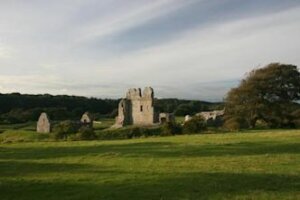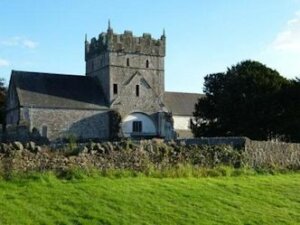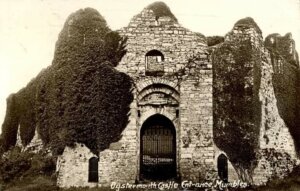Borrowed from Helen Nathaniel-fulton on Facebook 15 April 24:
Long before a stone Oystermouth Castle looked out over the Bay, in Roman times historians believe there was a naval station (Mansio) at Oystermouth & a few minor Roman industrial enterprises nearby … hence Roman coins found in the vicinity & mosaic fragments in the church of All Saints which may denote the position of the commander’s quarters.
But when William de Londres appeared with his soldiers from the east in the late 11th to early 12th century, it must have once again seemed a remote & peaceful place inhabited by a few native farmers, craftsmen, fishermen & their families.
The Normans were laying claim to the whole of South Wales & in our area Henry de Beaumont was in process of subduing the native Welsh for his King & friend Henry I & building a castle at Swansea.
His knights & allies were also given leave to build castles – & William de Londres was one, of an old, noble Norman family members of which had come across with the Conqueror.
I didn’t realise until recently their name has nothing to do with London – a senior branch of the family at the conquest was given land in Fife, Scotland near Lundin – hence becoming de Lundin, or, in French form, de Londres. Thus it’s unsure which part of Normandy they originated from: like the de Penres family of Gower they took the name of the land they were given to replace the original.

Ogmore Castle
William himself had – as the conquering Norman lords usually did – land & interests spread over a wider area. He had come into possession of Ogmore too & must have been a highly trusted & esteemed knight as he figured large in the government of the Lordship of Gower from 1106 & became one of the legendary 12 Knights of Glamorgan.
Indeed he’s thought to have been the 1st Steward of Gower or Seneschal as the French called it & was allowed to build & own Oystermouth Castle. It was a wood & earthen castle at that stage in a magnificently strategic high spot overlooking Mumbles & Swansea Bay. It mirrored the Roman mansio that had also used the site to be aware of all shipping in the area.
William was married to a lady called Matilda de Molle & he died in 1131.
His son Maurice de Londres during his father’s lifetime had taken control of Ogmore. His father had built a wooden castle but Maurice built an early stone keep c 1126. After the death of his father, he also inherited control of Oystermouth.
During the Welsh uprising after the death of King Henry I, he was the one to make a counter-attack. The defeat of the Normans at the Battle of Llwchr north of Swansea, the Lordship HQ shocked the incomers: they didn’t usually lose pitched battles – it hurt their plans & pride.

Kidwelly Castle
Thus in 1136 Maurice led a Norman army into battle at Kidwelly against the native Welsh. They were led by Princess Gwenllian of Deheubarth, as her husband Gruffydd had gone north to seek out support.
This very rare example of a woman leading an army into battle in Medieval Britain is posted on separately. In short, Gwenllian was captured & beheaded on the orders of de Londres – along with one of her children.
Though extreme brutality was then the norm, Maurice had a dark reputation already, enhanced by this act. The Normans must still have been smarting after Llwchr, keen to regain dominance & set a terrible example.

Ewenny Priory
It always astounds how violent mediaeval lords were, but would then try to gain favour from God by founding churches & abbeys. There is still a living legacy from Maurice as he founded All Saints Church & Ewenny Priory.
The Ewenny church of St Nicholas had been built in the 12th century by his father, William & the village grew around the priory & church. If you want to see Maurice’s tomb, it’s remains are in the priory.
C 1159 however, in a kind of payback, Maurice lost control of Kidwelly to Rhys ap Gruffydd of Deheubarth, son of Gwenllian, who was fighting back hard to regain territory.
With his wife Adeliza, Maurice had two sons, another William de Londres (d in 1211) & Thomas, who succeeded his father.

Oystermouth
When the last de Londres of South Wales died with no heir however Oystermouth Castle reverted in 1215 to the Lords of Gower, by then the de Braoses. They rebuilt the castle in stone – as they did with that of Swansea – & Welsh attacks became less effective & rarer so by the 14th century both were comfortable residences as well as fortresses – & in South Wales the de Londres were soon largely forgotten.
They remained powerful for some time in Scotland however – & there is still a Clan Lundin.
 Ann Marie Thomas is the author of five medieval history books, a surprisingly cheerful poetry collection about her 2010 stroke, and the science fiction series Flight of the Kestrel, Intruders, Alien Secrets & Crisis of Conscience are out now Follow her at http://eepurl.com/bbOsyz
Ann Marie Thomas is the author of five medieval history books, a surprisingly cheerful poetry collection about her 2010 stroke, and the science fiction series Flight of the Kestrel, Intruders, Alien Secrets & Crisis of Conscience are out now Follow her at http://eepurl.com/bbOsyz




 Ann Marie Thomas is the author of five medieval history books, a surprisingly cheerful poetry collection about her 2010 stroke, and the science fiction series Flight of the Kestrel, Intruders, Alien Secrets & Crisis of Conscience are out now Follow her at http://eepurl.com/bbOsyz
Ann Marie Thomas is the author of five medieval history books, a surprisingly cheerful poetry collection about her 2010 stroke, and the science fiction series Flight of the Kestrel, Intruders, Alien Secrets & Crisis of Conscience are out now Follow her at http://eepurl.com/bbOsyz